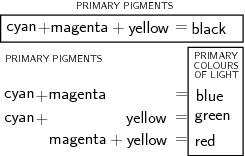| << Chapter < Page | Chapter >> Page > |
We have learnt that white light is a combination of all the colours of the visible spectrum and that each colour of light is related to a different frequency. But what gives everyday objects around us their different colours?
Pigments are substances which give an object its colour by absorbing certain frequencies of light and reflecting other frequencies. For example, a red pigment absorbs all colours of light except red which it reflects. Paints and inks contain pigments which gives the paints and inks different colours.
Objects which you cannot see through (i.e. they are not transparent) are called opaque . Examples of some opaque objects are metals, wood and bricks. The colour of an opaque object is determined by the colours (therefore frequencies ) of light which it reflects . For example, when white light strikes a blue opaque object such as a ruler, the ruler will absorb all frequencies of light except blue, which will be reflected. The reflected blue light is the light which makes it into our eyes and therefore the object will appear blue.
Opaque objects which appear white do not absorb any light. They reflect all the frequencies. Black opaque objects absorb all frequencies of light. They do not reflect at all and therefore appear to have no colour.
If we shine white light on a sheet of paper that can only reflect green light, what is the colour of the paper?
Since the colour of an object is determined by that frequency of light that is reflected , the sheet of paper will appear green, as this is the only frequency that is reflected. All the other frequencies are absorbed by the paper.
The cover of a book appears to have a magenta colour. What colours of light does it reflect and what colours does it absorb?
We know that magenta is a combination of red and blue primary colours of light. Therefore the object must be reflecting blue and red light and absorb green.
If an object is transparent it means that you can see through it. For example, glass, clean water and some clear plastics are transparent. The colour of a transparent object is determined by the colours (frequencies) of light which it transmits (allows to pass through it). For example, a cup made of green glass will appear green because it absorbs all the other frequencies of light except green, which it transmits. This is the light which we receive in our eyes and the object appears green.
If white light is shone through a glass plate that absorbs light of all frequencies except red, what is the colour of the glass plate?
Since the colour of an object is determined by that frequency of light that is transmitted , the glass plate will appear red, as this is the only frequency that is not absorbed.
The primary pigments and paints are cyan , magenta and yellow . When pigments or paints of these three colours are mixed together in equal amounts they produce black . Any other colour of paint can be made by mixing the primary pigments together in different quantities. The primary pigments are related to the primary colours of light in the following way:

What colours of light are absorbed by a green pigment?
If the pigment is green, then green light must be reflected . Therefore, red and blue light are absorbed.
I have a ruler which reflects red light and absorbs all other colours of light. What colour does the ruler appear in white light? What primary pigments must have been mixed to make the pigment which gives the ruler its colour?
We need to determine the colour of the ruler and the pigments which were mixed to make the colour.
The ruler reflects red light and absorbs all other colours. Therefore the ruler appears to be red.
Red pigment is produced when magenta and yellow pigments are mixed. Therefore magenta and yellow pigments were mixed to make the red pigment which gives the ruler its colour.
If cyan light shines on a dress that contains a pigment that is capable of absorbing blue, what colour does the dress appear?
Cyan light is made up of blue and green light.
If the dress absorbs the blue light then the green light must be reflected, so the dress will appear green!
| Column A | Column B |
| red | yellow |
| green | cyan |
| blue | magenta |

Notification Switch
Would you like to follow the 'Siyavula textbooks: grade 12 physical science' conversation and receive update notifications?